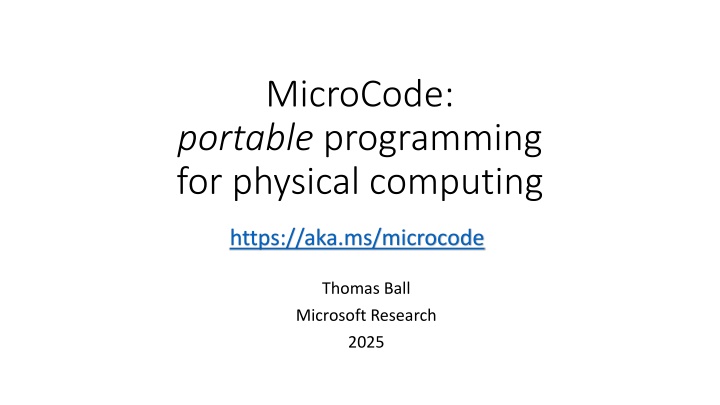
Exploring Physical Computing and MicroCode Programming for Physical Systems
Uncover the world of physical computing through MicroCode programming, portable data science, music, lights, and robotics. Dive into the realm of software and hardware that interact with the real world, ranging from LED matrices to accelerometers and magnetometers. Discover how physical computing merges human-designed and evolved biological systems, enhancing communication, transportation, and more.
Download Presentation

Please find below an Image/Link to download the presentation.
The content on the website is provided AS IS for your information and personal use only. It may not be sold, licensed, or shared on other websites without obtaining consent from the author. If you encounter any issues during the download, it is possible that the publisher has removed the file from their server.
You are allowed to download the files provided on this website for personal or commercial use, subject to the condition that they are used lawfully. All files are the property of their respective owners.
The content on the website is provided AS IS for your information and personal use only. It may not be sold, licensed, or shared on other websites without obtaining consent from the author.
E N D
Presentation Transcript
MicroCode: portable programming for physical computing https://aka.ms/microcode Thomas Ball Microsoft Research 2025
Portable Data science Music, lights Robots Programming Physical Computing
Physical Computing ~ software+hardware that senses and responds to the real world
2016 25 LED matrix screen Light sensor User definable buttons 17 Digital input/output 6 Analog input 3 PWM output 3 Touch sensitive I2C, SPI, UART
2016 16MHz Cortex M0 16KB RAM, 256K FLASH AA battery powered USB Storage/Serial/Debug 3 axis accelerometer 3 axis magnetometer Temperature sensor Bluetooth Low Energy
My Personal Interest in Physical Computing Systems everywhere! Digital systems (human designed) and biological systems (evolved) Motion: 3-axis accelerometer and our vestibular system Memory: what is it good for? A lot! Feedback: autonomous nervous system, temperature, homeostasis, Incorporation of computers into most of our modern systems Communication, transportation, economic,
The Micro:bit Educational Foundation, 2016- https://microbit.org "inspire every child to create their best digital future [reducing] barriers of access, for children living in different social and economic contexts around the world Over 10 million micro:bits distributed to date primarily to developed countries main programming environments are web-based
Microsoft MakeCode and CODAL (Lancaster University) makecode.microbit.org maker.makecode.com Web sites Web sites makecode.adafruit.com Blockly and JavaScript Editors Static TypeScript Web app Web app Simulator Compiler CODAL C++ Runtime Devices Devices
Innovations Innovations Web app for end-to-end experience in-browser compilation to binary https://github.com/microsoft/pxt Blockly TypeScript as core language coverage of OO concepts https://github.com/microsoft/TypeScript Static TypeScript Runtime abstractions Events, message bus and co-routines https://github.com/lancaster-university/codal C++ File format for flashing over USB https://github.com/microsoft/uf2
2020: micro:bit V2 Cortex-M4 32-bit processor with FPU Flash 512KB RAM 128KB https://tech.microbit.org/hardware/
2020: micro:bit V2 Cortex-M4 32-bit processor with FPU Flash 512KB RAM 128KB https://tech.microbit.org/hardware/
MicroCode Goals: [reducing] barriers of access, for children living in different social and economic contexts around the world bring BBC micro:bit to those lacking access to laptop/desktop computers, reliable internet, mains power bring the micro:bit experience to earlier ages Assumptions, non-assumptions Literacy (not assumed, should work for pre-literate) Arithmetic (adding numbers, fingers)
MicroCode: https://aka.ms/microcode MicroCode portable programming Leverages four commercially available Arcade shields for the V2 Open source https://github.com/microsoft/microcode
MicroCode Value Proposition Fun and creative Simple and live icons first (text second) cursor-based navigation (very) accessible instant micro:bit update Extensible via Jacdac plug-and-play Remote control robot cars
Cursor-based editing Action Shield Move cursor Direction pad Select item A button Go back B button
Cursor practice Move to an LED image and select Change the LED image Dismiss LED image editor Select to toggle LED
Space Out! Press Space (or A button) to create your first rule
Experience to date Meet MicroCode: a Live and Portable Programming Tool for the BBC micro:bit, IDC 2024, https://dl.acm.org/doi/10.1145/3628516.3656995 Reviewed 87 MakeCode quick projects for the micro:bit on https://microbit.org. MicroCode currently can cover 28/43 Beginner projects 11/29 Intermediate projects 5/15 Advanced projects Teaching with MicroCode (one focused on micro:bit, the other on robots) Steamlabs (https://steamlabs.ca/) expert brainstorming -> teacher workshop
Commercial Availability https://microsoft.github.io/microcode /docs/purchase https://www.kittenbot.cc/products/ki ttenbot-microcode-explorer-kit- computer-free-programming
